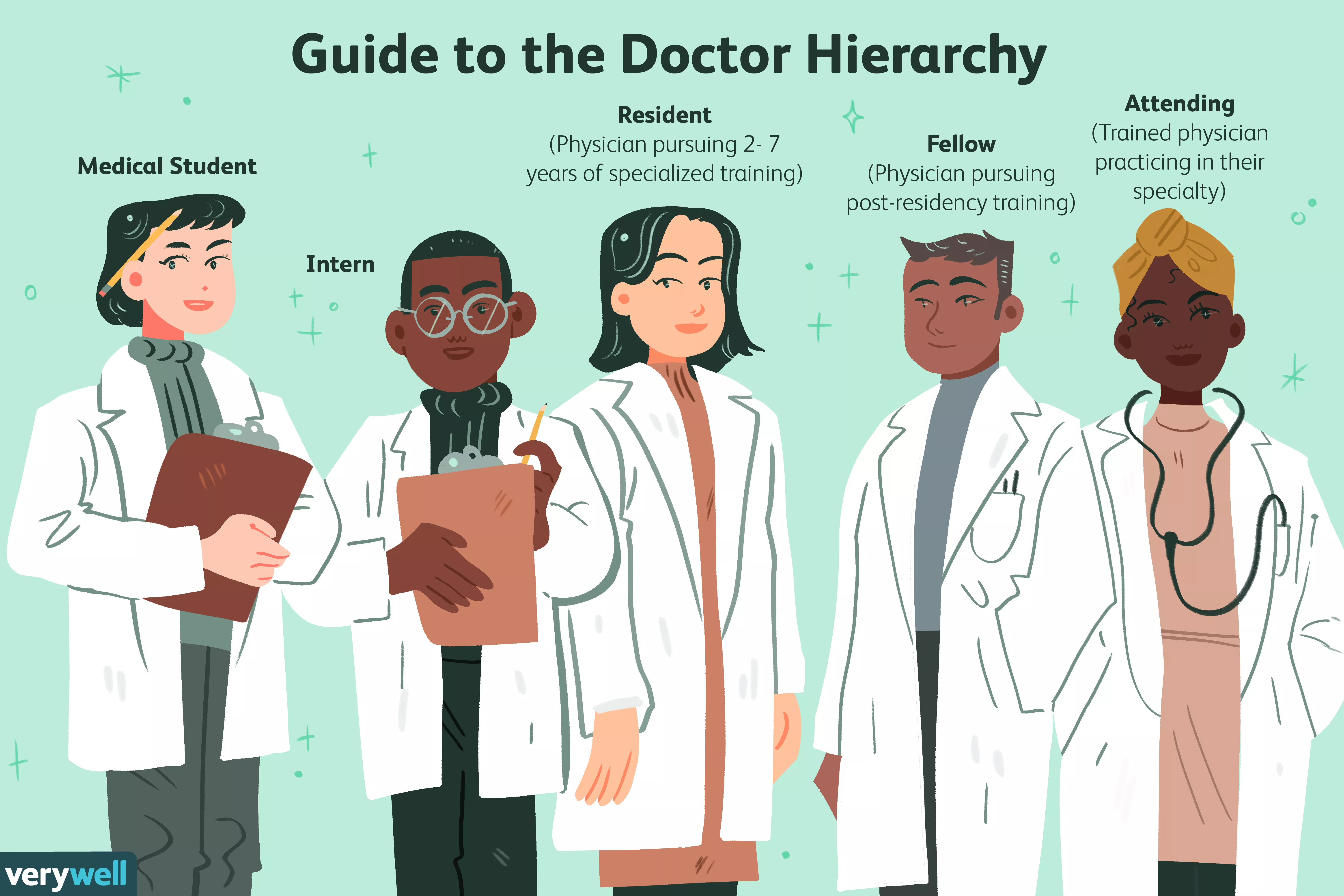Medical team
If you are being treated in a hospital you may be confused by the wide variety of different titles that are used for physicians. This quick guide should help clarify the roles and education levels of the different students and physicians you may see during a hospitalization.
In a large teaching facility, you may see individuals ranging from medical students who are not licensed physicians, physicians in training, and others who are fully trained and supervising other physicians.

Medical School Education
In the United States, an individual must complete high school and obtain a bachelor's degree prior to beginning medical school. In order to apply to medical school, the student must complete a bachelor's degree and coursework in biology, physics, and chemistry.
In some cases, a school may combine the bachelor's program with the medical school program, but these programs are less common than the traditional bachelor's degree followed by medical school program of study.
A teaching facility is traditionally a hospital that offers training to doctors after they complete medical school. University-based hospitals are typically teaching facilities, but smaller hospitals and hospitals not affiliated with a school may also be teaching facilities.
Physician vs. Doctor
A physician is a medical doctor, either an M.D. or D.O., who has completed graduate training to provide health care. A physician may be referred to as a doctor. However, not all doctors are physicians.
An individual with a PhD, such as a doctoral degree in economics, is referred to as a doctor. So while all physicians are doctors, not all doctors are physicians.
Does It Make a Difference If Your Doctor Is a DO or MD?
Medical Students
Individuals who are in medical school are referred to as medical students. They are not referred to as a doctor or physician until they graduate from medical school. Once they graduate, they are called a physician even though their training is not complete and they will continue to learn from experienced physicians for several years before practicing independently.
Residents
After completing medical school, almost all doctors enter a residency program. While practicing independently is possible, the vast majority of physicians choose to pursue a residency for further training.
Residency can range from an additional two years of education to an additional seven years of training, depending on the specialty. For example, a family practice residency would be two years of residency while a surgery residency may last five, seven, or more years.
Fellows
A fellow is a physician who has completed their residency and elects to complete further training in a specialty. The fellow is a fully credentialed physician who chooses to pursue additional training, the fellowship is optional and is not required to practice medicine, but is necessary for training in a subspecialty.
To be clear, after a general surgery residency a physician is fully qualified to perform general surgery independently. The fellowship is necessary for more specific training, such as pediatric neurosurgery.
Example:
A cardiothoracic surgeon would complete a residency in general surgery. After residency, they would complete a fellowship in cardiothoracic surgery, which would provide more specific training in heart and lung procedures.
Attendings
An attending physician has completed their training and is practicing independently in their chosen specialty. This term is typically used at teaching facilities to differentiate fully credentialed senior-level physicians from junior physicians who are still completing their higher education.
In the hierarchy of physicians, the attending is at the top under only the physicians who run the hospital itself, while the medical student is at the bottom. Attendings may also be known as staff physicians or a rendering doctor and may be trained as an MD or a DO.
What an Attending Physician Does
An attending is considered an expert in their field of medicine or surgery. These physicians are typically working at a facility that provides education to physicians and may play an active role in that education. An attending typically has their own practice in their specialty that may include teaching residents and fellows. An attending may also oversee the practice and education of medical students.
For example, a surgical attending performs surgery as part of their job. As an attending, they may have interns, residents, or fellows in the operating room with them, educating them on how to perform surgery. They may also provide lecture style education, and often include physicians in training when they round on patients, which is when physicians check on their patients daily.
Attending may have additional titles that indicate their role in the education of physicians. They may have the title of professor, associate professor, or could potentially be a dean at a medical school.
These titles may vary from institution to institution and vary based on the role the physician takes in the academic portion of medicine, and how much of their work is devoted to education rather than independent practice.
Short Coats vs. Long Coats
While it is generally true that the shorter the coat, the less training an individual has received, the short coat versus long coat rule is not absolute. The shortest white coats are worn by medical students, who are not physicians until they graduate.
Residents typically wear longer coats and attendings wear a full-length coat. Other professions in healthcare also wear lab coats, including nurse practitioners, phlebotomists, and other allied health professionals.
While this general rule holds true, personal preference often dictates the length of the coats worn (if one is worn at all) by an attending, so coat length is not an absolute indication of what level of training a physician has completed.
The reality is that many physicians wear whatever they choose, and you may see one physician wearing jeans, another wearing scrubs and yet another physician wearing a suit and white lab coat. It is no longer safe to assume that a person in scrubs, or even a lab coat, is a surgeon.
A Word From Verywell
It can be very confusing to keep all of the different types of doctors straight, and even more confusing when it seems like everyone in the hospital is wearing scrubs in a rainbow of colors.





